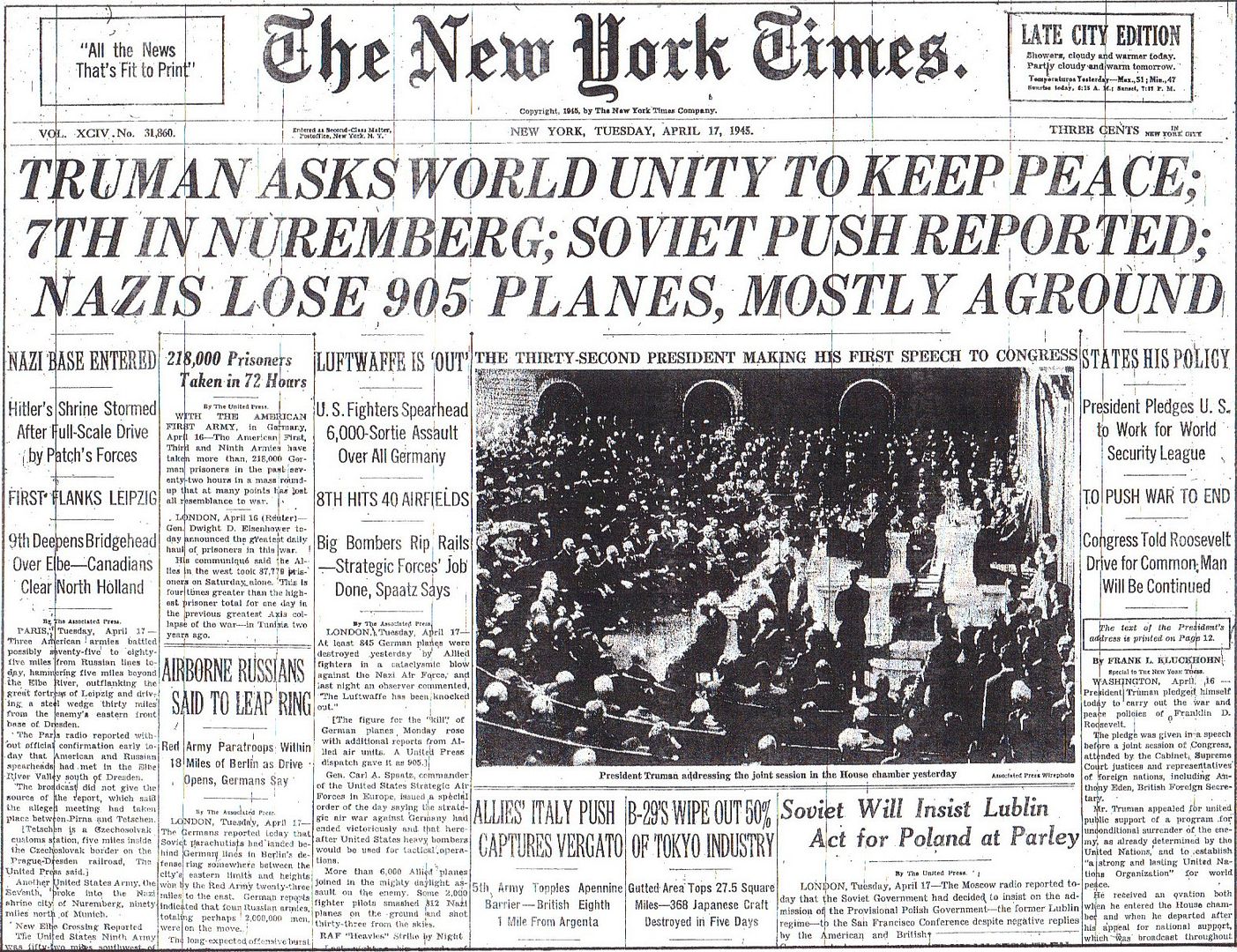
Posted on 04/17/2015 4:12:13 AM PDT by Homer_J_Simpson

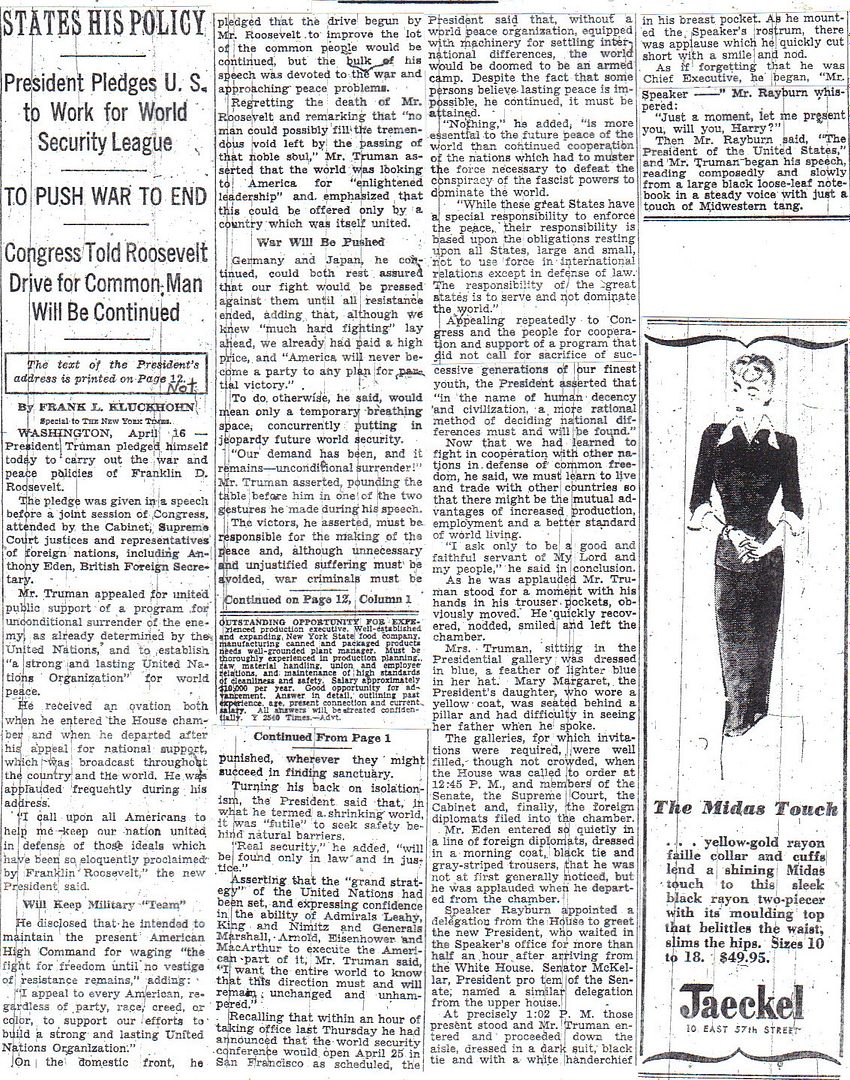
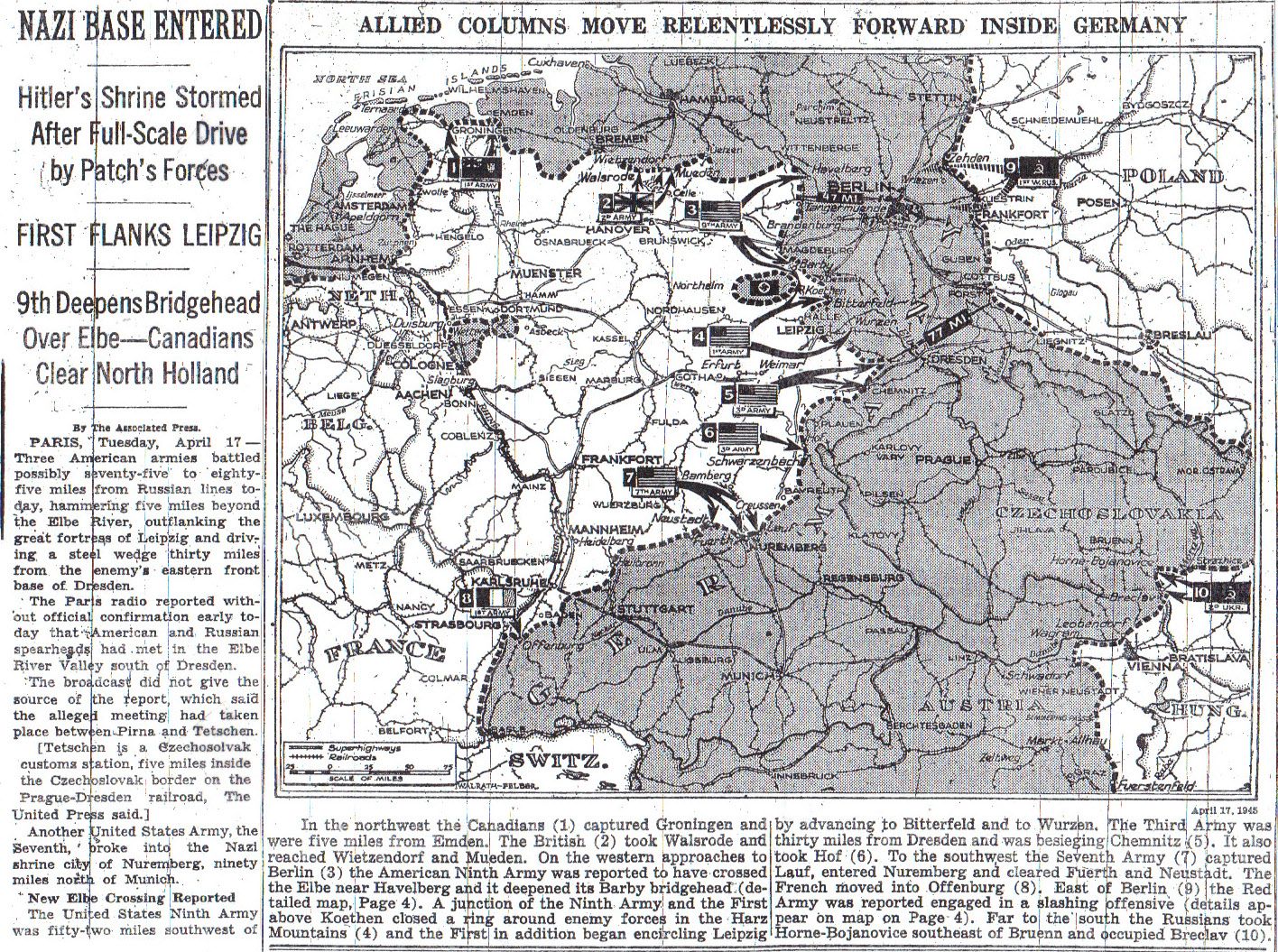
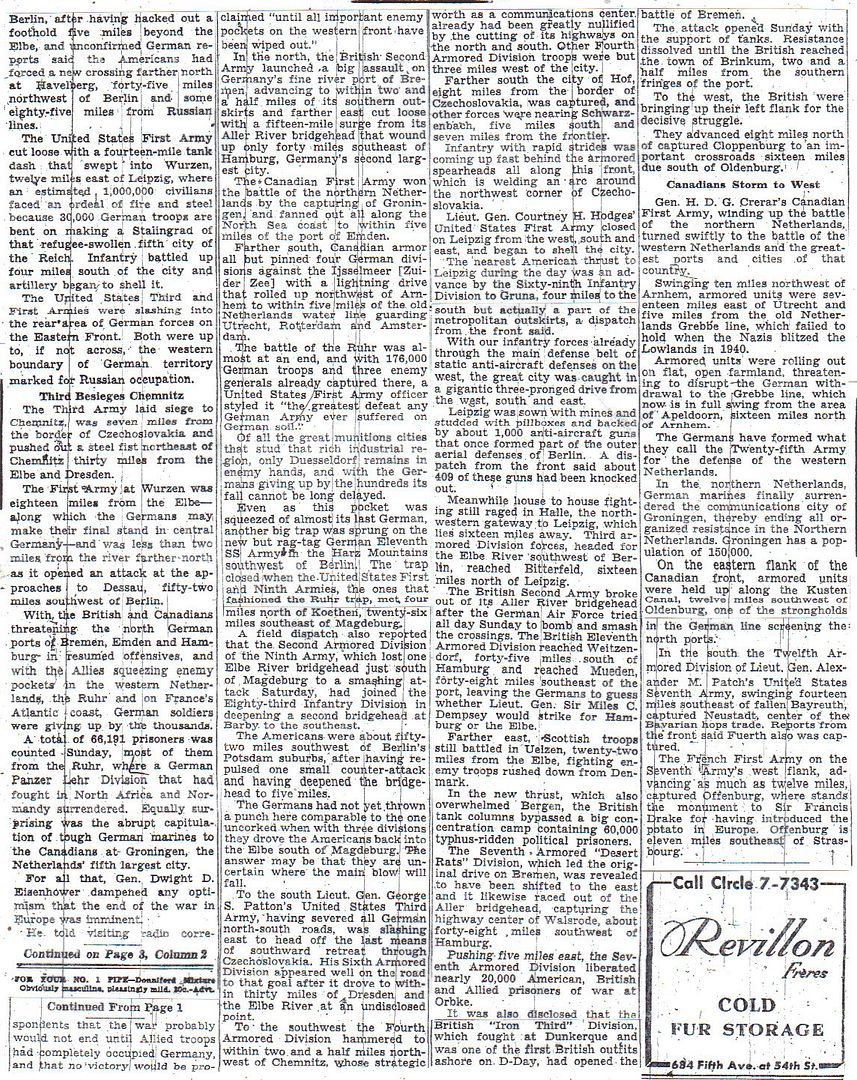
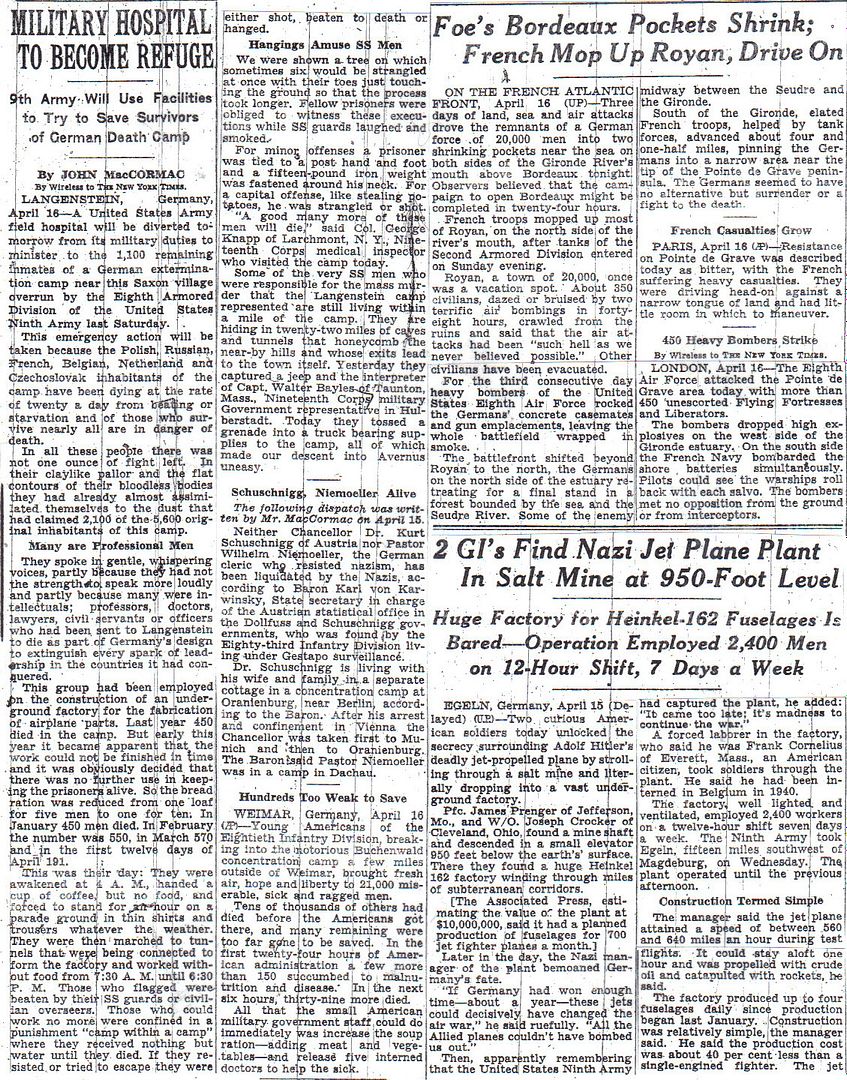

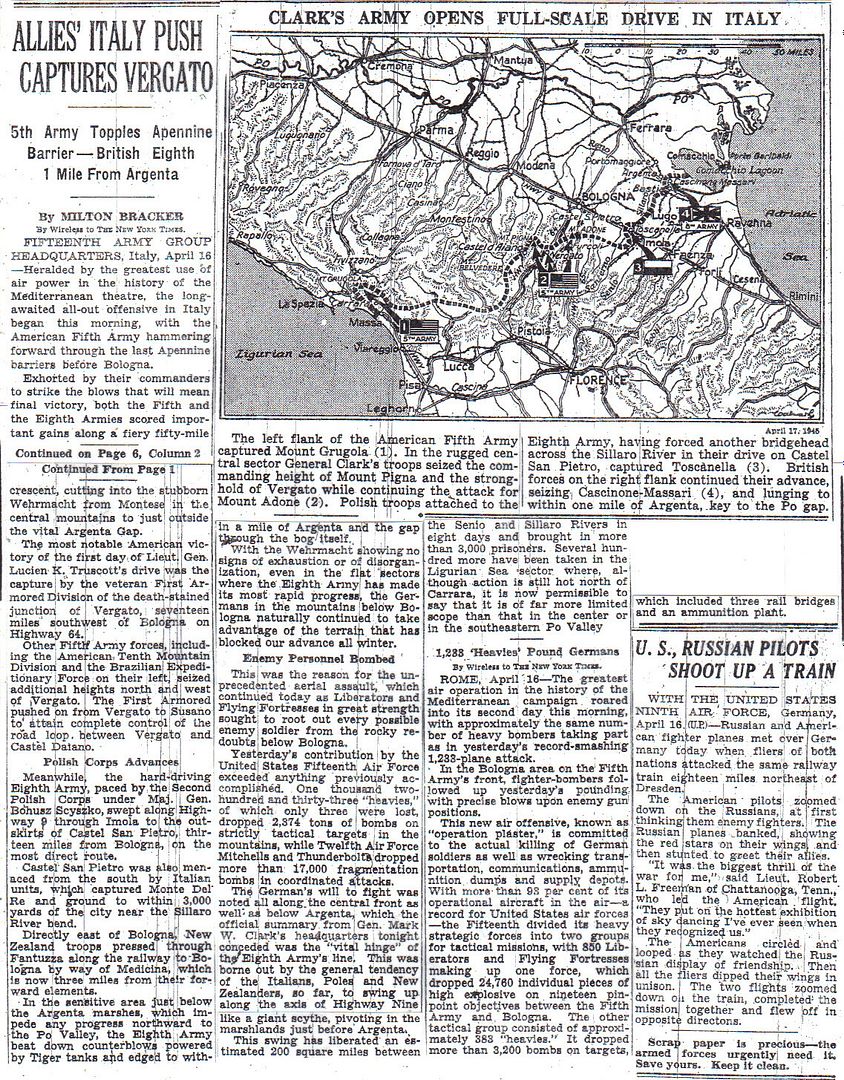
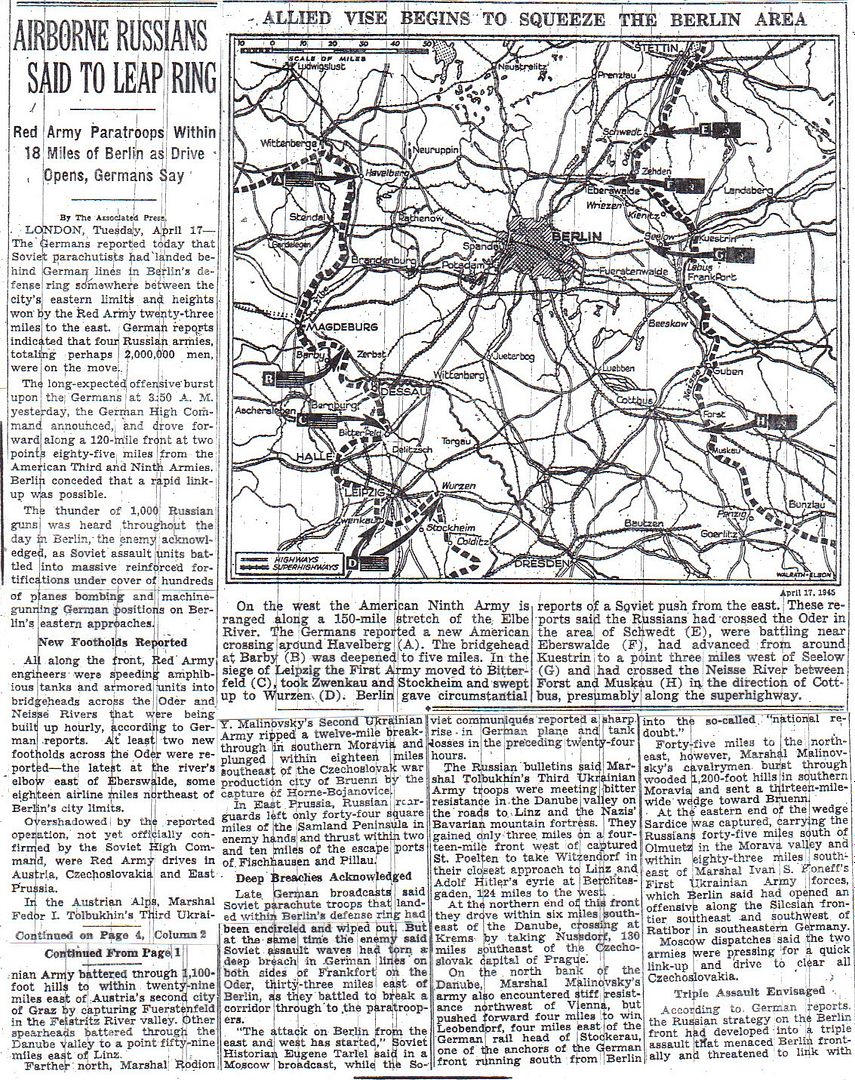
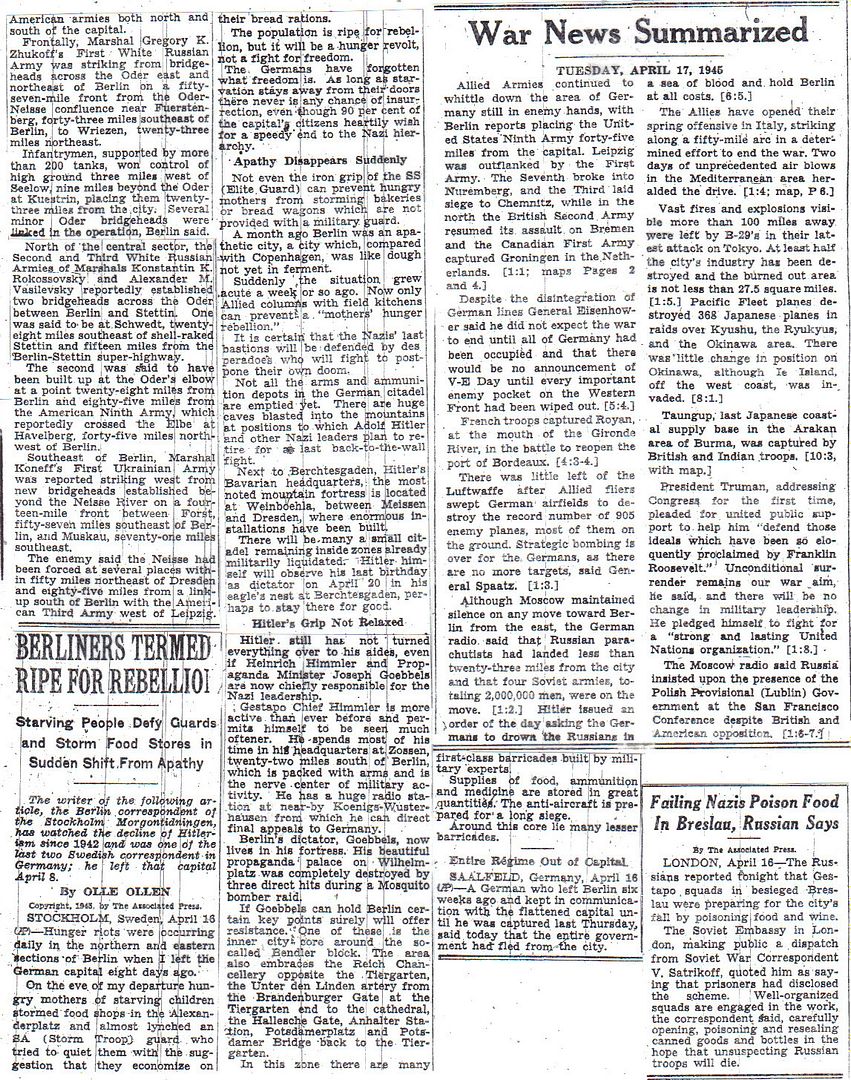
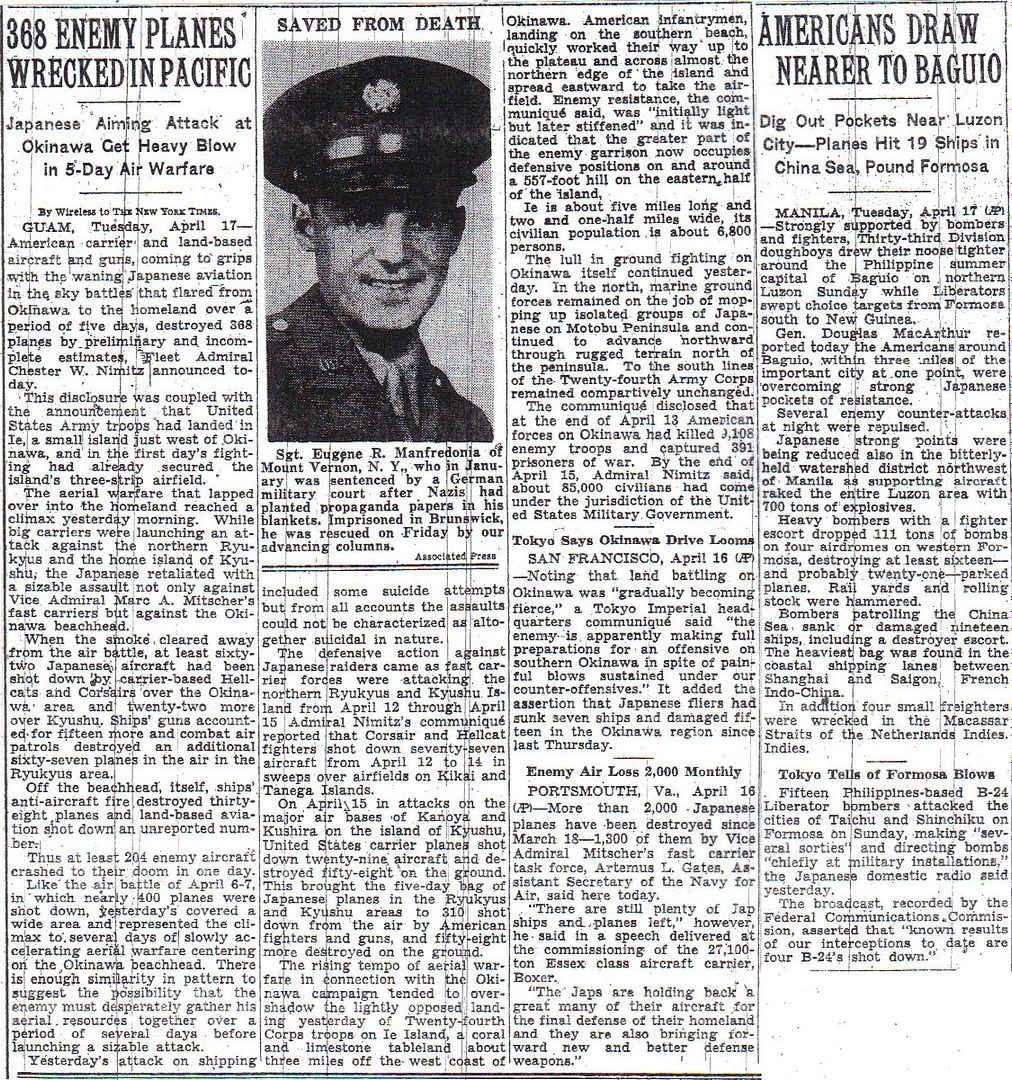

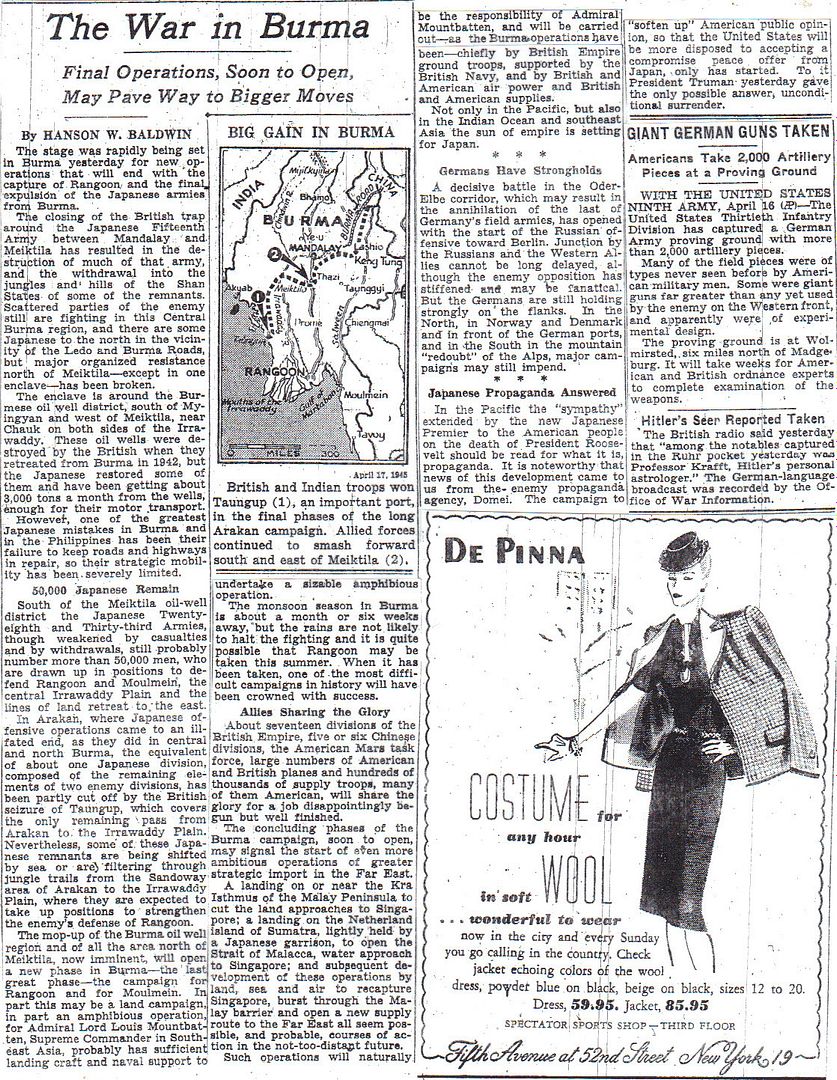
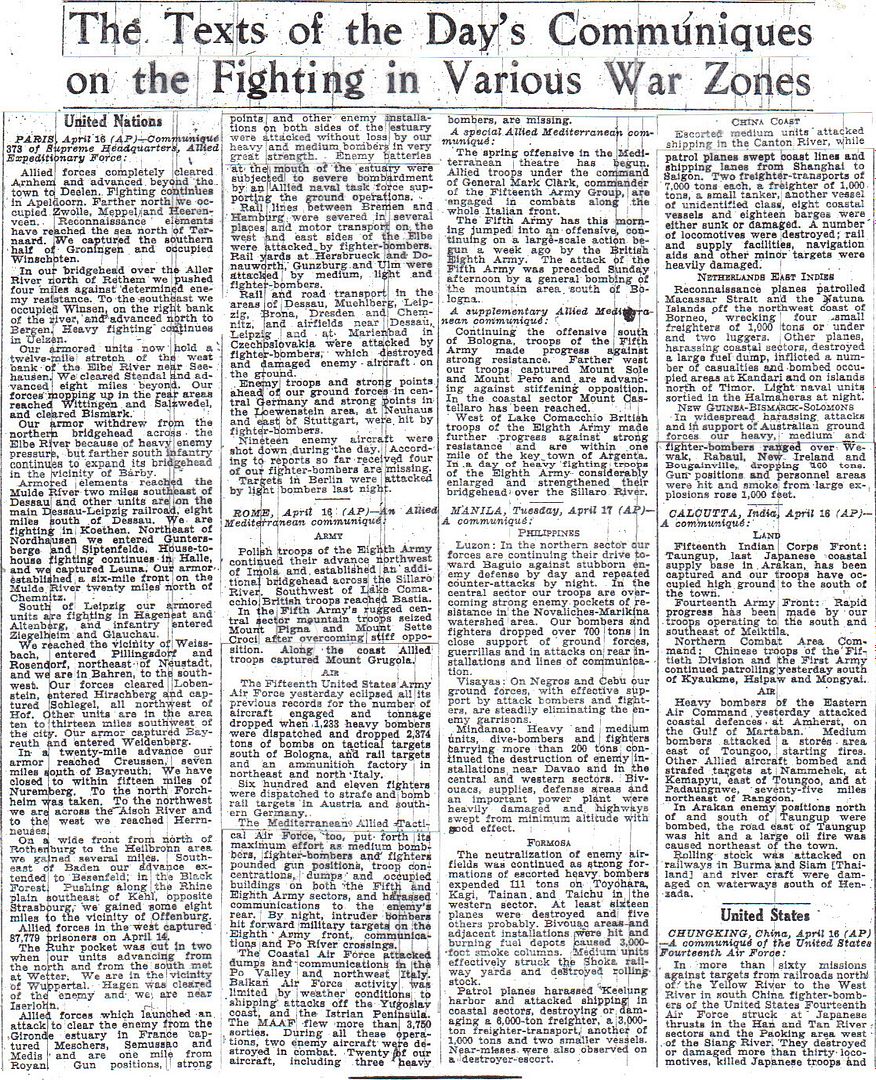
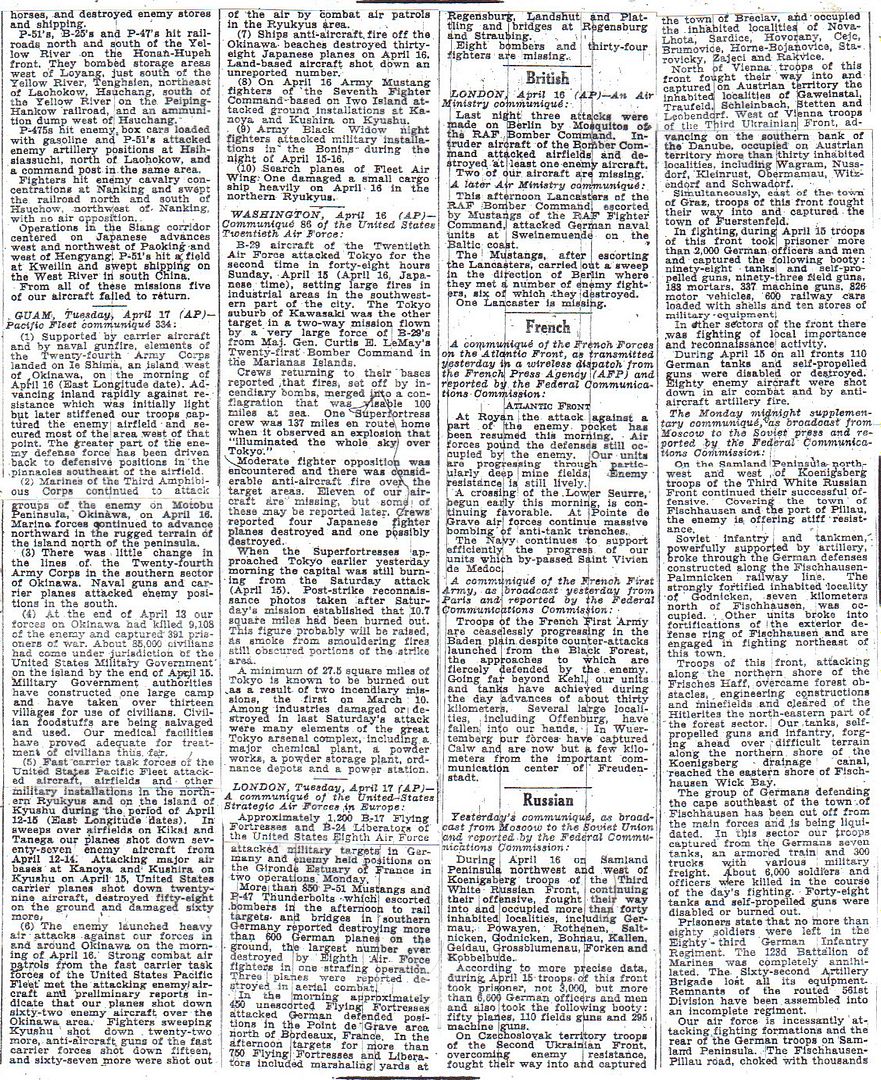
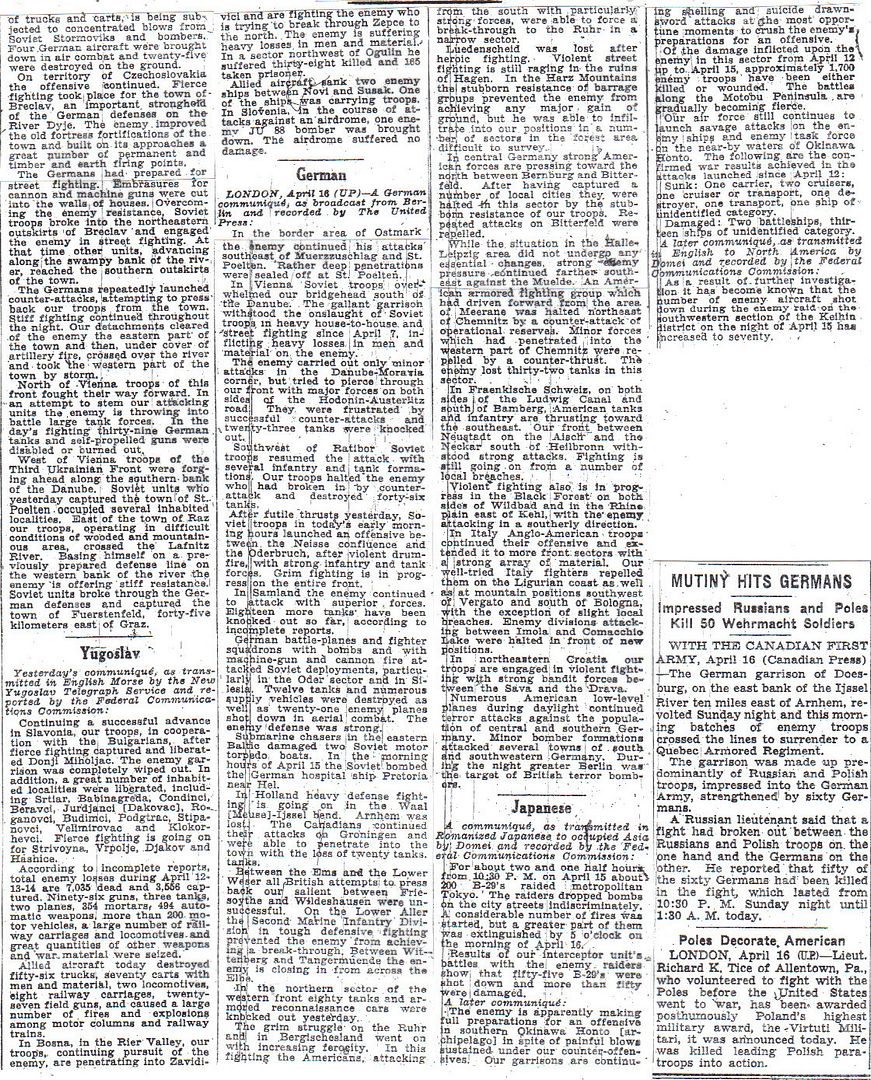

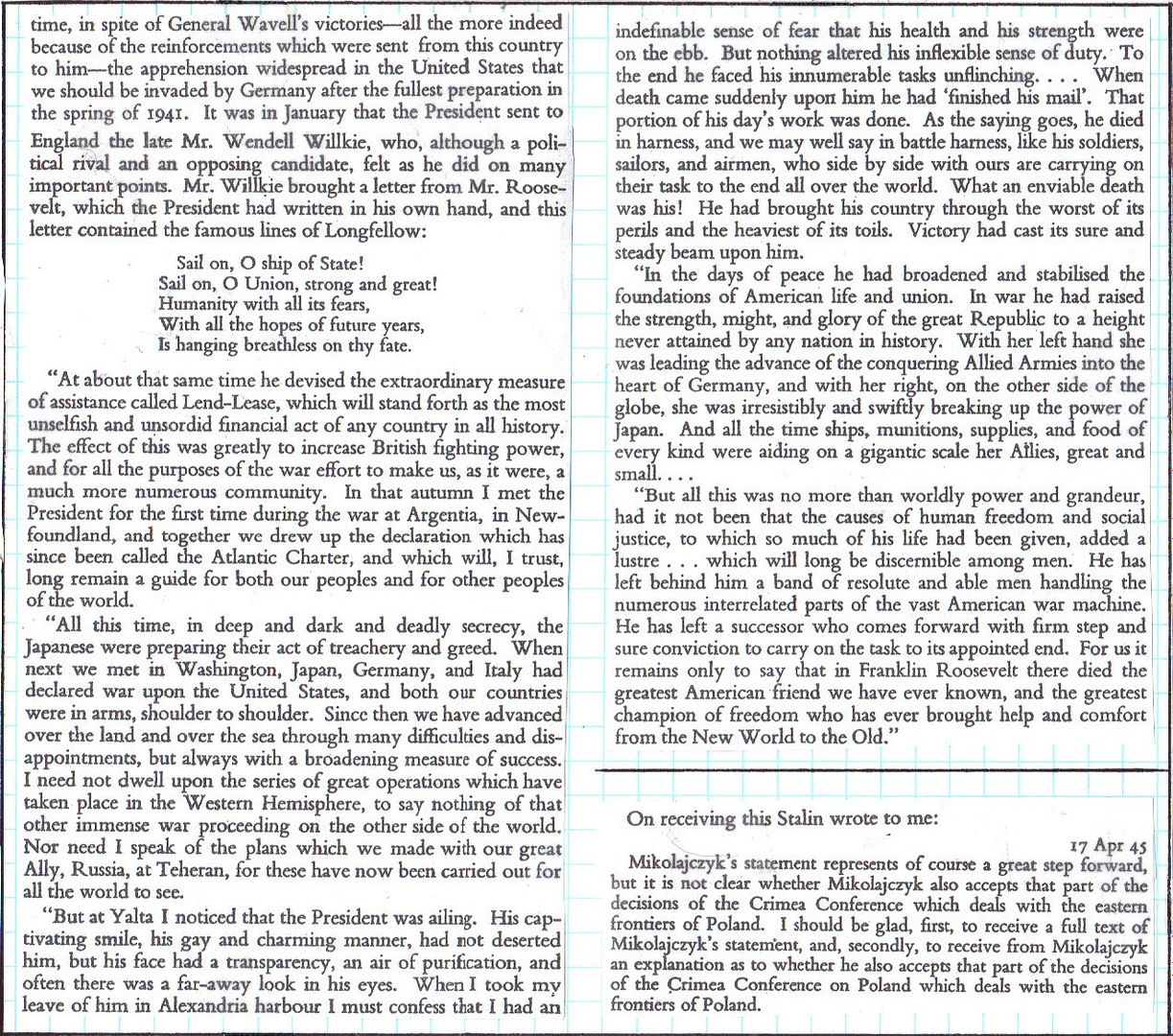
Winston S. Churchill, Triumph and Tragedy
http://www.etherit.co.uk/month/3/17.htm
April 17th, 1945 (TUESDAY)
UNITED KINGDOM: 981 of 1,054 Eighth Air Force B-17s and B-24s bomb rail targets in south-eastern Germany and Czechoslovakia; 756 of the 816 P-47s and P-51 dispatched escort the bombers and then attack ground targets.
GERMANY: Large scale German surrenders begin in the Ruhr area.
Allied bombing has destroyed over a thousand Luftwaffe aircraft on the ground as US troops reach Magdeburg.
The Ninth Air Force’s 9th Bombardment Division attacks the defended city of Magdeburg (including numerous gun positions in the area), marshalling yard and ordnance depot at Aalen, marshalling yard and ordnance depot at Tubingen, and ordnance depot at Ravensburg; fighters fly escort to the bombers, fly patrols, area cover, and armed reconnaissance, hit airfields at Marianske Lazne and Michalovy Hory, and support the US 3d Armored Division mopping up south of the Elbe River and west of the Mulde River near Dessau, the 9th Armored Division along the Mulde east of Leipzig, the VIII Corps in the Greiz-Zwickau area, the XX Corps southwest of Chemnitz, the 5th Armored Division at the Knesebeck Forest, south of Wittingen, and the 2d Armored Division opening an assault on Magdeburg.
Bergen-Belsen: There is a pile of naked female corpses here, 80 yards long by 30 yards wide and four feet high. You can’t see any faces; just bony elbows, knees and buttocks or twisted hands and feet. It looks like the overladen counter of an insane butcher’s shop where flies dance on the mound of greying flesh.
It is two days since the British Army agreed a truce with the local German commander which enabled them to enter the camp peacefully. The Hungarian army guards who stayed on duty “to prevent a mass breakout”, have shot dead 83 prisoners for minor offences. Now the British are in full control, and a Jewish sergeant, Norman Turgel, has arrested Josef Kramer, the camp’s commandant.
Kramer’s men have been disarmed and put to work burying the estimated ten thousand dead lying around the camp. They have to be locked up to protect them from the vengeance of prisoners. Yesterday seven Kapos [prisoner-guards] were savagely beaten to death.
About 30,000 victims, mostly Jews, gypsies and political prisoners, are still alive, but raging epidemics of typhus and dysentery threaten to finish off the deadly work that the Nazis started. British medical staff are now struggling to save lives and halt the spread of disease. Derrick Sington, the first British officer to enter the camp, told how a Hungarian-Jewish girl took him to a clearing: “Three hundred yards away was a mound of bodies, six feet high. A crosswind was blowing and carrying into our nostrils the stench of putrefying flesh.”
U.S. Lieutenant Colonel Boris T. Pash commandeers over half a ton of uranium at Strassfut, in an effort to prevent the Soviets from developing an A-bomb. Pash was head of the Alsos Group, organized to search for German scientists in the post-war environment in order to prevent the Soviets, previously Allies but now a potential threat, from capturing any scientists and putting them to work at their own atomic research plants. Uranium piles were also rich “catches,” as they were necessary to the development of atomic weapons.
The Eighth Air Force flies Mission 957: 1,054 bombers and 816 fighters are dispatched to hit rail targets in eastern Germany and western Czechoslovakia (see above); 50 Luftwaffe fighters are encountered, mostly jets and the AAF claims a total of 300-0-119 aircraft destroyed on the ground and in the air (including 4 jets); 8 bombers and 17 fighters are lost.
- 152 B-17s bomb the rail centre at Dresden and 276 bomb the marshalling yard at Dresden; they claim 1-0-1 aircraft; 6 B-17s are lost. Escorting are 230 P-51s; they claim 2-0-3 aircraft in the air and 91-0-37 on the ground; 2 P-51s are lost.
- 76 B-17s bomb the Dresden area and 86 attack the rail junction and station at Aussig; 86 hit the secondary target, the marshalling yard at Dresden; 2 B-17s are lost. 265 P-51s escort claiming 11-0-2 aircraft in the air and 142-0-47 on the ground; 14 P-51s are lost.
- 55 B-24s hit the rail centre and junction at Fischern while 37 bomb the rail junction and bridge at Falkenau. The escort is 228 P-47s and P-51s; they claim 53-0-29 aircraft on the ground; 1 P-51 is lost.
AUSTRIA: 147 Fifteenth Air Force P-38s dive-bomb railroad bridges at Seefeld and Mariahof.
CENTRAL EUROPE: Fifteenth Air Force P-51s, with 10 flying top cover, strafe targets of opportunity in the Munich, Germany, Plzen, Czechoslovakia, and Linz, Austria areas.
CZECHOSLOVAKIA: During the Eighth Air Force’s Mission 957, 115 B-17s bomb an oil depot and marshalling yard at Roundnice and 36 B-24s bomb the rail junction and industry at Kladno and 61 bomb the railroad, rail industry and marshalling yard at Beroun.
ITALY: The British V Corps captures Argenta.
During the night of 16/17 April, Twelfth Air Force A-20s and A-26 Invaders hit Po River crossings and several towns west and southwest of Bologna; during the day B-25s successfully attack 4 Reno River bridges near Bologna and close support targets on the British Eighth Army front to the southwest, and extensively damage 4 bridges in northern Italy and Austria on the Brenner rail line; XXII Tactical Air Command fighters and fighter-bombers concentrate on close support of the US Fifth Army south and west of Bologna.
The Fifteenth Air Force dispatches 751 B-24s and B-17s, in support of the US Fifth Army, to hit troop concentrations, supply dumps, gun positions, and HQ immediately south and southwest of Bologna; 143 P-51s provide escort.
CHINA: The Fourteenth Air Force dispatches 4 B-25s and 4 P-51s to attack river shipping south of Yiyang; 6 B-25s bomb the area around Kwangsi University at Liang-feng; 2 B-24s bomb the Bakli Bay dock area on Hainan Island; 70+ P-51s and P-40s hit troops, town areas, road traffic, river shipping, and general targets of opportunity at several locations in southern and eastern China including Changsha, Sinning, Sinhwa, Yiyang, Tungting Lake, Paoching, Yungfengshih, Shanhsien, Lingling, Pingsiang, Tsinkong, and Hochih.
BURMA: 18 Tenth Air Force fighter-bombers hit troops and supplies near Mong Kung and Wan Hpun; 12 others attack vehicles and other targets of opportunity along roads south of the bomb line; 489 transport sorties are completed to forward areas throughout the day.
FORMOSA: Far East Air Forces B-24s bomb Taichu, Shinshoshi, Toyohara, and Okayama Airfields and B-25s hit the airfield at Taito.
JAPAN: The XXI Bomber Command flies Missions 70 to 75: 118 B-29 Superfortresses bomb airfields at Tachiarai, Kokubu, Izumi, Nittagahara, and 2 at Kanoya; 5 others attack targets of opportunity; beginning on this date and continuing through 11 May, XXI Bomber Command devotes about 75 per cent of its combat effort to support of the Okinawa campaign; during this period the B-29s fly more than 2,100 sorties against 17 airfields on Kyushu and Shikoku Islands which are dispatching air attacks (including Kamikaze raids) against USN and USMC forces.
OKINAWA: Off Okinawa, destroyer USS Benham (DD-796) is damaged by kamikaze and by friendly fire.
COMMONWEALTH OF THE PHILIPPINES: In Operation VICTOR FIVE, the U.S. Army’s X Corps consisting of the 24th and 31st Infantry Division is landed on Mindanao Island, Philippine Islands, near Malabang, Parang and Cotabato. The landings are supported by the cruisers and destroyers of Task Group 74.2.
The 24th Infantry Division lands near Malabang, Parang, and Cotabato on Mindanao Island by a naval attack group (Rear Admiral Albert G. Noble); the landings are supported by cruiser and destroyer gunfire and USMC aircraft (30 F4U Corsairs and 35 SBD Dauntlesses).
The defenders do not make a determined stand.
Far East Air Forces flies numerous sweeps and sorties in support of ground forces in Luzon, Cebu, Negros, and Mindanao Islands and the Sulu Archipelago. B-24s over Mindanao bomb Cotabato and Kabacan.
BONIN ISLANDS: 18 VII Fighter Command P-51s flying two strikes from Iwo Jima, attack vessels at Futamiko on Chichi Jima.
PACIFIC OCEAN: Four Japanese ships are sunk at sea:
- Mines sink a guardboat off Goto Rette.
- A USN PB4Y-1 Liberator of Patrol Bombing Squadron One Hundred Eleven (VPB-111) based at Palawan AAFld in the Philippines, sinks a cargo ship off the coast of Malaya.
- A mine laid by USAAF B-29 sinks a cargo ship off Shanghai, China.
- A mine laid by USAAF B-29 sinks a cargo ship off Wada Misaki light, Japan.
Japanese submarine RO.56 is sunk by the USS Sea Owl (SS-405) north of Marshall Islands. (Mike Yared)(144 and 145)
U.S.A.: Pete Gray, the one-armed Outfielder, plays his Major League debut game with the St. Louis Browns. He singles once, off Les Mueller, in four at bats, and handles no chances in the outfield. St. Louis beats the Detroit Tigers 7-1, for their 9th straight Opening Day win, a major-league record that the 1975-83 New York Mets will tie. (Rodney Sanders)
BUMP for later read
U.S. Lieutenant Colonel Boris T. Pash commandeers over half a ton of uranium at Strassfut, in an effort to prevent the Soviets from developing an A-bomb.
Pash was head of the Alsos Group, organized to search for German scientists in the post-war environment in order to prevent the Soviets, previously Allies but now a potential threat, from capturing any scientists and putting them to work at their own atomic research plants. Uranium piles were also rich “catches,” as they were necessary to the development of atomic weapons.
I saw that too.
I’m also wondering when the Army is going to inform President Turman about a little project called “Manhattan”.
The New York Times won’t be reporting that until August...
I posted some stuff the other day which indicated that Truman was informed of the Manhattan Project the day he was sworn in, but that it was unclear whether the import of it had really sunk in. It seems that it was about two weeks from his swearing in that he got a really thorough briefing.
http://marshallfoundation.org/library/digital-archive/memorandum-for-the-president-135/
General George C. Marshall Memorandum for the President, April 17, 1945
Publisher: The Johns Hopkins University Press
Date: April 17, 1945
Subject: World War II
Collection: Papers of George Catlett Marshall, Volume 5: The Finest Soldier
Summary
Memorandum for the President
April 17, 1945 [Washington, D.C.]
Top Secret
Attached is one of the daily TOP SECRET summaries of extremely secret information. It is based on a purely British source, which incidentally involves some 30,000 people, and we have bound ourselves to confine its circulation to a specific and very limited number of people.1 Therefore I request that this be “For Your Eye Only”.
I am sending this particular sample to you because it contains authentic information regarding two very important matters.
First, Hitler’s instructions for the defense of the “Fortress Zone” of Holland. As the British Army approaches this Zone we are confronted with the probability, almost the certainty, that the Germans will flood with salt water a large area of occupied Holland.2 It would then be about 10 years before this land could be put again into cultivation. It is also probable that great destruction will be carried out not only in the port areas but in most of the communities as well. The situation of these people at the present time is tragic, as they have been starved to the point that some of them are going blind.3
The second item I wish to call to your attention is the report of the German commander in Italy, Von Vietinghoff, concerning the situation there.4 We have been in process for some days of the progressive launching of a general assault; the initial attacks were by the division on the west coast heading north towards Spezia and at the same time attacks eastward by the French divisions in the Alps on the western borderline of Italy. Next the British Eighth Army on the right of General [Mark W.] Clark’s front (he being in command of the whole) and now commencing yesterday the main attack by our troops in the center directly towards Bologna or to the west of that city.
With the Russians launching a general offensive along their central front, as well as continuing their thrust west and northwest from Vienna, with the attack of Clark’s two Armies along the Italian front, and considering the statements made by Von Vietinghoff in this secret document, you can see that we have the possibility of sudden and violent changes in the situation on the European continent.
The secret matter on the situation in the Ruhr pocket, reported on by General Model (former commander of the central group of western Armies) is interesting, but merely reflects the situation which we had anticipated.5
Document Copy Text Source: George C. Marshall Papers, Pentagon Office Collection, Selected Materials, George C. Marshall Research Library, Lexington, Virginia.
Document Format: Typed memorandum.
1. Cryptographers working at Bletchley Park deciphered German signals enciphered on the Enigma and other cipher machines. ULTRA denoted the highly secret intelligence derived from the decryption of intercepted German signal messages as well as the Japanese armed forces messages. For recollections of the intelligence work performed at Bletchley Park and the plan for its protection and dissemination, see F. W. Winterbotham, The Ultra Secret (London: Weidenfeld and Nicholson, 1974), pp. 17-25. According to Ronald Lewin, “The name Ultra, which came to cover loosely both the intelligence-system and the intelligence itself, was evolved by Winterbotham after discussion with the Directors of Intelligence of all three services. Beyond Secret, or Most Secret, or even Top Secret lay Ultra Secret. Ultra seemed simpler.” (Ronald Lewin, Ultra Goes to War: The First Account of World War II’s Greatest Secret Based on Official Documents [New York: McGraw-Hill Book Company, 1978], pp. 63-64.)
2. The Allies decrypted a German message of April 13 that ordered “ruthless use of flooding for the defence of Fortress Holland.” (F. H. Hinsley et al., British Intelligence in the Second World War: Its Influence on Strategy and Operations, volume 3, part 2, a volume in History of the Second World War [London: HMSO, 1988], pp. 725-27. The editors were unable to locate the attachment sent to President Truman.)
3. An Allied delegation met with the Germans on April 30 and worked out an arrangement by which relief would be provided to the Dutch citizens. Allied planes began dropping food on May 1. Arrangements were made to open one road into the occupied zone for Allied supply trucks and to allow food ships at Rotterdam. (Forrest C. Pogue, The Supreme Command, a volume in the United States Army in World War II [Washington: GPO, 1954], pp. 457-59.)
4. General Heinrich von Vietinghoff, commander of Army Group C, reported on April 14 that the Allies had “launched an all-out offensive with a superiority in material which was on a scale not hitherto experienced and which could not be counterbalanced” by his troops. (Hinsley, British Intelligence in the Second World War, vol. 3, pt. 2, p. 704. SUNSET 899 [April 16, 1945] and SUNSET 900 [April 17, 1945], NA/RG 457, Entry 9026.)
5. Field Marshal Walther Model reported on April 13 that the situation was “extremely critical,” the “northern part of industrial zone had been lost” and the area south of the Ruhr “could be held only for limited time.” Short on arms, ammunition, and fuel, Army Group B would “fight to last cartridge in order to tie down as long as possible strong elements of American Army facing it.” (SUNSET 899, April 16, 1945, NA/RG 457, Entry 9026.)
Recommended Citation: ThePapers of George Catlett Marshall, ed.Larry I. Bland and Sharon Ritenour Stevens(Lexington, Va.: The George C. Marshall Foundation, 1981- ). Electronic version based on The Papers of George Catlett Marshall, vol. 5, “The Finest Soldier,” January 1, 1945-January 7, 1947 (Baltimore and London: The Johns Hopkins University Press, 2003), pp. 147-149.
Truman Address broadcast to the Armed Forces
April 17, 1945
http://www.trumanlibrary.org/educ/armedforces.htm
A powerful message, in my opinion.
His use of the famous Lincoln quote was brilliant, and timely.
Further reconnaissance determined that capture of the spur might possibly split the Jap line.
If a wedge could be driven into the Japanese positions at the point where the spur made a junction with the main ridge, it would then be possible to drive both north and south from the salient.
King Company jumped off on schedule.
The approach march, up terrain so steep that forward progress was limited to a few hundred yards an hour, passed without incident.
Slowly the company beat its way toward the objective, looking like on oversize snake unwinding itself on the slope.
Captain Hicks wondered at the absolute lack of opposition.
Lead scouts reported back that they could see the crest of the spur.
Still not a sign of resistance.
The scouts continued to edge forward.
Fifty, forty, and then twenty yards separated the lead platoon from the objective.
The only sound to be heard was the panting of the King Company doughs fighting their way uphill.
A few seconds later, with the lead scout only five yards shy of the objective, the enemy acted.
Ten machine guns covering King Company's front and flanks suddenly opened up in a full-throated roar.
Surprised doughs stood transfixed with shock for a fleeting moment and then dove for cover.
They Could do nothing to combat this overpowering deluge of fire.
Every attempt to move was met with point-blank fire.
In the first fusillade more than twenty men were hit.
Again the Jap had paused until the Blackhawks had walked into his muzzles before cutting loose.
Captain Hicks had but one choice: break contact and pull out.
But the enemy intended to forestall this move too.
Taking advantage of the shock created by the tremendous volume of surprise fire, a platoon of Nip riflemen quickly raced down the two draws flanking the company and converged on King's exposed rear.
More men went down before the company commander was able to muster what strength remained and direct a breakthrough.
Fighting for their lives, Company K doughboys overran this enemy platoon hacking at their rear, And withdrew down the ridge.
In a fire fight lasting only a few minutes, the company lost almost half its strength in killed or wounded.
Regiment and Division, in constant communication with the 3d Battalion CP, knew even before Hicks returned with his thirty casualties that further efforts along this route would prove equally destructive.
Patrol actions along other probable routes of approach met the same fate.
While Captain Hicks and King Company were fighting to break out of the Jap ambush, a combat patrol from Item Company was caught in a similar situation.
Led by T/Sgt. Paul D. Sterling, an Illinois Guardsman who had been with Item Company for more than four years, this platoon-sized unit had the mission of checking trails and enemy defenses in the area close to the tunnels.
Again the Japs held their fire until the Item troops were practically walking up their Nambu sights.
Concealed by huge clumps of thick cogon grass, the enemy suddenly blasted the platoon as Sergeant Sterling led it across a patch of open ground near the Japanese position.
While the first bursts of fire were shredding his outfit, Sergeant Sterling went into action.
Seeing the muzzle of a machine gun which had the unit enfiladed, the sergeant pulled the pin from a fragmentation grenade and charged the emplacement.
Miraculously he reached it unharmed.
He followed one grenade with another and the gun was destroyed.
There remained two Nambus which kept the platoon locked inside the ambush by short-range flanking fire.
Sergeant Sterling, instead of seeking cover, heroically exposed himself to the fires of the flanking guns, in the hope that his men would be able to spot the pieces and neutralize them.
Both guns turned their fires on him and he fell, mortally wounded.
But his plan worked.
The platoon split into two sections and enveloped both guns as the Japs swung their fires upon the sergeant.
Sergeant Sterling's sacrifice enabled the platoon to break contact and continue on its mission without additional casualties.
He was posthumously awarded the Distinguished Service Cross.
The facts were hard to swallow but at the same time childishly simple.
The Japanese had the western approaches to the ridge nailed down under a curtain of steel.
Like so many others, this too was destined to be a fight to the death."




)/RetrieveAsset.aspx?instance=IDAM_USHMM&qfactor=2&width=480&height=480&crop=0&size=1&type=asset&id=5555)
http://digitalassets.ushmm.org/photoarchives/detail.aspx?id=5555
Escorted by American soldiers, a transport of child survivors of Buchenwald file out of the main gate of the camp.
The original caption reads, "Internees at the Buchenwald Concentration Camp near Weimar Germany march from the camp to receive treatment at an American hospital after the camp was captured by U.S. Third Army troops." The boys are accompanied by American soldiers and directed by elements of the camp underground who watd over them, including Polish Jews Yakov Werber and Eli Grinbaum (on the right). Among the children pictured are Izio Rosenman (head of column), Jacques Finkel, Charles Finkel, Fredek Margolis, Lalek Russ, Salek Sandowski, George Goldbloom and ? Zylber. Misho Frailich, Willi Fogel, A. Grossman, Lotci Miller, Laiza Grynberg, Usha Grynberg, David Perlmutter, Marek Lodzinsky, Yankel Kapelush, Yosel Dziubak, Loyosh Hershkovitz, ? Yakubovitz, Reuven Wekselman, Stanley Weinstein, Herschek Zeit, Henryk Kolber, Jacques Werber and Philip Kaner. Mor Stern is the boy in the beret and white coat, with right arm hanging down straight just right of the two American soldiers.
The Buchenwald children were a group of approximately 1000 Jewish child survivors found by American troops when they liberated the Buchenwald concentration camp on April 11, 1945. Most of the children were originally from Poland, though others came from Hungary, Slovenia and Ruthenia. Unsure of what to do with the child survivors, American army chaplains, Rabbi Herschel Schacter and Rabbi Robert Marcus, contacted the offices of the OSE (Oeuvre de Secours aux Enfants), the Jewish children's relief organization in Geneva. They arranged to send 427 of the children to France, 280 to Switzerland and 250 to England. [Vivette Samuels reverses the figures for England and Switzerland in her monograph, "Sauver les Enfants."] On June 2, 1945 OSE representatives arrived in Buchenwald, and together with Rabbi Marcus escorted the transport of children to France. Rabbi Schacter accompanied the second transport to Switzerland. Because of the difficulty in finding clothing for the children, the boys were clad in Hitler Youth uniforms. This created a problem, for when the train crossed into France, it was greeted by an angry populace who assumed the train was carrying Nazi youth. Thereafter the words "KZ Buchenwald orphans" were painted on the outside of the train to avoid confusion. On June 6, 1945 the French transport arrived at the Andelys station and the orphans were taken to a children's home in Ecouis (Eure). The home had been set up to accommodate young children, but in fact only 30 of the boys were below the age of 13. This was only one of the many problems faced by the OSE personnel, who were not prepared to handle a large group of demanding, rebellious teenagers who were full of anger for what they had experienced. At Ecouis the boys were given medical care, counseling and schooling until more permanent accommodations could be found. Most of the children remained only four to eight weeks at Ecouis before being moved elsewhere, and the home was closed in August 1945. Among the first to leave were a group of 173 children who had family in Palestine. They were given immigration certificates and departed from Marseilles in July aboard the British vessel, the RMS Mataroa. The remaining boys at Ecouis were soon transferred to other residences and homes. Some of the older ones were sent to the Foyer d'Etudiants located on the rue Rollin in Paris, where they boarded while attending vocational training courses or working at jobs in the city. Others were sent to the Chateau de Boucicaut home in Fontenay-aux-Roses (Hauts-de-Seine). Many of the boys came from religiously observant homes. Since the OSE could not obtain kosher food for everyone, they divided the children into religious and non-religious groups. Dr. Charly Merzbach offered OSE the use of his estate, the Chateau d'Ambloy (Loir-et-Cher) for the summer, and between 90 and 100 boys chose to go there in order to receive kosher food and live in a religious environment. In October 1945 the children and staff of Ambloy were relocated to the Chateau de Vaucelles in Taverny (Val d'Oise). About 50 of the non-religious boys were taken to the Villa Concordiale in Le Vesinet (Yvelines) near Paris that housed an equal number of French Jewish orphans. In the summer they went to the Foyer de Champigny in Champigny-sur-Marne (Val-de-Marne). In all the homes attended by the Buchenwald children vocational training as well as regular classroom instruction was offered. At the same time OSE social workers made every effort to locate surviving relatives, succeeding in about half the cases. By the end of 1948 all of the Buchenwald children who had come to France had left the OSE fold and begun new lives for themselves.
[Sources: Hemmendinger, Judith and Krell, Robert. "The Children of Buchenwald." Gefen Publishers, 2000; Grobman, Alex. "Rekindling the Flame." Wayne State University Press, 1993; Hazan, Katy, "Chronologie de l'histoire de l'OSE L'action de l'OSE apres la guerre." (31 December 2002).]
The Heinkel 162 - designed, tested, put into production, and then into combat, in about 4 months.
http://www.aviation-history.com/heinkel/he162.html
April 17, 1945 – Ernie Pyle killed in action

Ernie Pyle, considered the GI’s war correspondent, was killed by Japanese sniper fire on the tiny island of Ie Shima off the coast of Okinawa on April 17, 1945. His death was universally mourned by Americans on the homefront and in the armed services.
The son of an Indiana farmer, Pyle became a roving war correspondent at the outbreak of World War II. Starting with the German bombing of England in 1940, Pyle went with the U.S. Army to North Africa in 1942, covered the invasions of Sicily and Italy, accompanied Allied troops during the Normandy landings, witnessed the liberation of France and then moved on to the Pacific.
By 1944 Pyle had established himself as one of the world’s outstanding reporters. He applied an intimate style to the war. Instead of the movements of armies or the activities of generals, Pyle wrote from the perspective of the common soldier, an approach that won him great popularity and also the Pulitzer Prize in 1944. In that year, he wrote a column urging that soldiers in combat get “fight pay” just as airmen were paid “flight pay”. Congress passed a law giving soldiers 50 percent extra pay for combat service and called it “the Ernie Pyle bill.”
In a letter to his wife early in 1945, Ernie Pyle wrote, “Of course I am very sick of the war and would like to leave it, and yet I know I can’t. I’ve been part of the misery and tragedy of it for so long that I feel if I left it, it would be like a soldier deserting.”
Author John Steinbeck said about Ernie Pyle: “There is the war of maps and logistics, of campaigns, of ballistics, armies, divisions, and regiments. Then there is the war of homesick, weary, funny, violent, common men, who wash their socks in their helmets, complain about food, whistle at Arab girls, or any other girls for that matter, and lug themselves through as dirty a business as the world has ever seen and do it with humanity and dignity and courage – and that is Ernie Pyle’s war.”
PAGE FOUR THE PORT ARTHUR NEWS EDITORIAL PAGE TUESDAY, http://ethistory.blogspot.com/2013/04/april-17-1945-ernie-pyles-tribute-to.html
APRIL 17. 1945.
Marines Hate War
Just Like Soldiers
By Ernie Pyle
OKINAWA, (By Navy Radio).—The bulk of the battle of Okinawa
is being fought by the Army—my old friends, the doughfoots.
This time the Marines had it easy, and by the turn of circumstance the Army is the one that has the job to do.
But my self-assignment on the Okinawa blitz was to write about the Marines and that’s what I continue to do. I landed with the Marines, cross the Island with them, and have been living with them amidst fleas, mosquitoes, goats and a few Japs, hiding under bushes. So naturally I want to tell you about them.
Marine corps blitzes out here have all been so bitter and the Marines have performed so magnificently that I had conjured up a mental picture of a Marine that bore a close resemblance to a man from Mars. I was almost afraid of them myself.
I did find the Marines confident, but neither cocky nor smart-alecky. I found they have fears, and qualms, and hatred for war the same as anybody else. They want, to go home just as badly as any soldiers I’ve ever met. I found them good, human Americano.
They are proud to be Marines. They wouldn’t be in any other branch of the service. Yet they are not arrogant about it. And I found they_ have a healthy respect for the infantry.
Join In Praising Army Division
One day we were sitting on a hillside talking about the infantry. One Marine spoke of a certain Army division—a division they had fought beside—and was singing its praises. “It’s as good as any Marine division,” he said.
“What was that you said” a listener cut in. The Marine repeated it and emphasized it a little. Another Marine stood up and called out, loudly:
“Did you hear what he said? This guy says there’s an
Army division an good as any Marine, division. ‘ He must be
crazy. Haw haw, haw!”
And yet other boys chimed in, arguing very soberly, and sided with the one who had praised the Army division.
An Outfit of Ordinary People
Before I came into the field , several Marine officers asked me to try to sense just what the Marine spirit is, just what caused it, and keeps it alive.
In peacetime when the Marine corps was a small outfit, with its campaigns highlighted, and everybody was a volunteer you could understand why Marines felt so superior.
But since the war the Marine corps has grown into hundreds of thousands of men. It has been diluted, so to speak. Today it is an outfit of ordinary people—some big, some little, some even draftees. It has changed, in fact, until Marines look exactly like a company of soldiers in Europe.
Yet that Marine corps spirit still remains. I never did find out what perpetuates it. They’re not necessarily better trained. They’re no better equipped and often not as well supplied as other troops. But a Marine still considers himself a better soldier than anybody else, even though nine-tenths of them don’t want to be soldiers at all.
Envisioned Corps End at Okinawa
The Marines are very cognizant of the terrible casualties they’ve taken in this Pacific war. They’re even proud of that too, in a way. Any argument among Marine units is settled by which has had the greatest casualties.
Many of them even envisioned the end of the Marine corps at Okinawa. If the Marine divisions had been beaten up here as they were on Iwo Jima, the boys felt it would have been difficult to find enough men of Marine corps caliber to reconstitute all the divisions.
They even had a sadly sardonic song about their approach to Okinawa, the theme of which was, “Goodby, Marines!”
Marines Don’t Thirst for Battles
The boys of my regiment were continuously apologizing too : because this started out as a mild campaign. They felt I might think less of them because they didn’t show me a blood bath.
Nothing could have been farther from my mind. I was probably the happiest American over here when things turned out for us as they did. I told them that kind of campaign suited me. And without exception they came back with the answer that it suited them, too.
I heard it said so many times that it almost became a chant-It they could all be like this, we wouldn’t mind war so much.”
So you see, Marines don’t thirst for battles. I’ve read and heard enough about Marines to have no doubt whatever about the things they can do when they have to. No Marine need ever apologizes for anything.
The Marines are O. K. for my money. In battle or out.
Canadian army repels desperate Germans near war’s end
Audio of Radio Broadcast
April 17, 1945: OTTERLO, Netherlands -- "Victory is in the air," says CBC war correspondent Matthew Halton. The war is winding down. But even as Canadian forces continue their sweep through enemy-occupied Holland, the Germans aren't giving up without a fight. In a bid to get back into western Holland, 1,000 German soldiers launch an attack at Otterlo, tossing grenades and firing on the Canadians. Reuters war reporter Charles Lynch tells the story for CBC. Canadian gunners fire back at the Germans before digging slit trenches and using Sten submachine-guns, rifles and pistols to repel the attackers. But once the Germans get past the gun lines there's only one way to stop them. The Canadians roll four flamethrowers into position, sending flames into advancing columns of Germans. When it's all over Canadian casualties are light, but 400 Germans have been killed and 250 taken prisoner.
Disclaimer: Opinions posted on Free Republic are those of the individual posters and do not necessarily represent the opinion of Free Republic or its management. All materials posted herein are protected by copyright law and the exemption for fair use of copyrighted works.